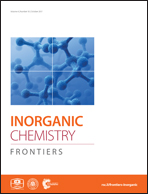Carbon dots/Fe3O4 hybrid nanofibers as efficient peroxidase mimics for sensitive detection of H2O2 and ascorbic acid
Abstract
In recent years, carbon dots (CDs) based hybrid nanomaterials have received considerable attention due to their outstanding optical and catalytic properties. Herein, CDs/Fe3O4 hybrid nanofibers are prepared via a facile electrospinning technique combined with a hydrothermal reaction and a thermochemical reduction process. During the synthetic process, α-Fe2O3 nanofibers are synthesized via electrospinning followed by a calcination process first. Then CDs modified α-Fe2O3 nanofibers can be obtained under a hydrothermal reaction. Finally, the prepared CDs modified α-Fe2O3 nanofibers are converted to CDs/Fe3O4 hybrid nanofibers through a thermochemical reduction process. The resulting CDs/Fe3O4 hybrid nanofibers show a superior peroxidase catalytic activity to individual CDs, α-Fe2O3 nanofibers, CDs/α-Fe2O3 hybrid nanofibers and commercial Fe3O4 nanoparticles. The steady-state kinetic assay exhibits an excellent affinity for TMB with a low Michaelis–Menten constant (Km) value. On the basis of the high peroxidase-like activity of CDs/Fe3O4 hybrid nanofibers, a simple approach for the colorimetric detection of H2O2 and ascorbic acid (AA) with a low detection limit of 0.917 and 0.285 μM, respectively, is developed. This work inspires researchers to develop functional hybrid nanomaterials for fabricating superior biomimetic catalysts and extends their applications in biosensors and environmental monitoring.



 Please wait while we load your content...
Please wait while we load your content...